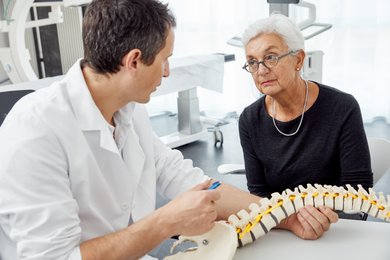Treatments
Opioids against chronic pain

What are opioids?
Opioids form a class of active substances that can be traced back to opium, which occurs naturally in the opium poppy.
Opioids have an impact on the central nervous system, where they mediate various effects, in particular those of pain relief. Pain signals sent from the body to the brain can be weakened or blocked by opioids. Due to this property, opioids are often used to treat moderate to severe pain conditions.
Depending on the dosage, treatment with opioids may also be accompanied by side effects such as nausea, constipation, itching, increased sweating, drowsiness, confusion or critically slowed breathing.
The use of opioids is not risk-free and should only be administered under medical supervision. Opiates lead to physical dependence. In addition, uncontrolled use can lead to psychological dependence in the sense of addiction.
Before starting pain therapy with opioids
In principle, one must distinguish between cancer-related and non-cancer-related pain.
If possible, chronic non-cancer pain should never exclusively be treated with opioids. Scientific data indicate that opioids are not more effective compared to other pain medications for the treatment of chronic non-cancer pain. Before considering pain therapy with opioids, various other therapeutic measures should have already been taken or at least tried (physical, physiotherapeutic, medicinal, interventional, psychological).
The use of opioids involves various risks, which can be considerably influenced by patient-specific factors (age, concomitant diseases, concomitant medications, ...). In order to avoid serious complications, a detailed medical risk-benefit assessment is always necessary before starting pain therapy with opioids.
Opioids for non-cancer pain
According to the German AWMF guideline on the use of opioids for non-cancer pain, pain therapy with opioids can be considered for the following indications:
- Pain in diabetic polyneuropathy
- Pain after shingles / postherpetic neuralgia
- Chronic arthritis pain
- Chronic back pain
- Phantom limb pain
- Chronic pain after spinal cord injury
- Chronic pain from nerve root damage
- Chronic pain from rheumatoid arthritis
If possible, the duration of treatment should be limited to 4 to 12 weeks. During this time, other treatment options should be evaluated and tried so that the use of opioids can be dropped again later. Opioid therapy should only be continued for longer than 12 weeks if there is a clear, significant pain-reducing benefit.
In case of doubt: The intravenous opioid test as a guide
In case of doubt as to whether opioid therapy should be tried or continued for more than 12 weeks, an outpatient intravenous (i.v.) opioid test can be helpful. Through the recorded i.v. administration of a short-acting opioid, it is usually possible to figure out whether a pain condition can be effectively treated by an opioid or not.
Opioids are NOT recommended in these cases
Opioid therapy is NOT recommended for the treatment of the following non-cancer pain conditions:
- Migraine
- Tension headaches
- Chronic lower abdominal pain in women
- Irritable bowel syndrome
- Fibromyalgia syndrome (except tramadol)
- Chronic inflammatory bowel disease
- Chronic pancreatitis
- In various psychiatric diseases
Adverse effects with long-term use
Long-term use of opioids may result in the following adverse effects:
- Loss of sexual desire
- Impotence
- Menstrual irregularities in women
- Increased overall mortality
- Passivity / listlessness
- Impaired memory
- Increased risk of falling
Dependence and addiction
Opioids lead to physical dependence. With correct indication and dosage, as well as regular medical re-evaluation, the probability of addiction is small. However, if the indication is questionable and the use is uncontrolled, there is a risk of psychological dependence in the sense of addiction.
Termination of opioid therapy
Pain therapy with opioids should be periodically re-evaluated and only given under regular medical supervision. If it is unclear whether the therapy with an opioid causes pain relief, the therapy should be discontinued.
In case of doubt, an outpatient i.v. opioid test can facilitate the decision for or against a continuation of treatment.
Driving / operating machinery
During the first 1 - 3 weeks of therapy (adjustment phase), while increasing the dose or changing to another opioid, driving or operating machinery should be avoided. During this time, side effects are common and limit the ability to react.
Alcohol should be consumed with caution during opioid therapy. Alcohol further impairs the ability to react, thus driving should be avoided after consuming alcohol.
References
- Häuser W, et al., Clinical practice guideline: Long-term opioid use in non-cancer pain. Dtsch Arztebl Int 2014; 111: 732–40.
- Maurer K. Vom Umgang mit Opioiden bei nicht tumorbedingten Schmerzen. HAUSARZT PRAXIS 2016; Vol.11, Nr. 7
- Manchikanti L, et al., Opioids for Chronic Non-Cancer Pain: American Society of Interventional Pain Physicians (ASIPP) Guidelines. Pain Physician 2017; 20:S3-S92
- Gustorff B., Intravenous opioid testing in patients with chronic non-cancer pain. Eur J Pain. 2005 Apr;9(2):123-5.

















